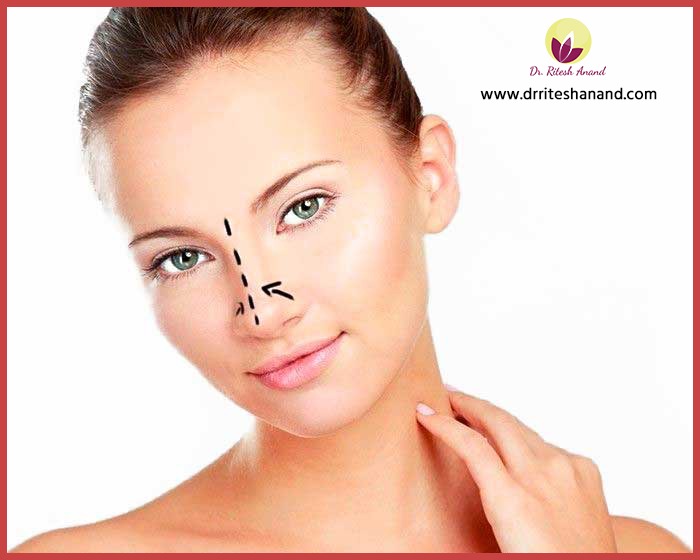Learn About Nose Surgery

Nose surgery or Rhinoplasty is a surgery which is used to change the shape of the nose. Some people go for nose surgery to change their appearance while others use it to improve some medical conditions such as breathing problems. Rhinoplasty can be used to change the bone, cartilage, or skin of the nose. Rhinoplasty can improve size, shape, and proportion of your nose. The best Cosmetic Surgery in Delhi is usually done to repair birth defects, nose deformities from injury, or improve breathing difficulties.
Rhinoplasty Procedure
Nose surgery is an outpatient procedure which means you do not have to stay overnight after the procedure. Rhinoplasty does not have ordered a series of steps. Each nose surgery is unique and customized for the specific needs of the person. The surgery is performed under local or general anaesthesia depending on the complexity of the surgery.
General anaesthesia
Under general anaesthesia, you receive the drugs inhaling through a small tube placed in your vein. General anaesthesia effect and their body and you remain unconscious throughout the procedure.
Local anaesthesia
The local part of your body remains unconscious. In rhinoplasty, under local anaesthesia only your nose remains numb and you do not feel any pain. To give surgeon injects pain-numbing medication into your natural tissues and sedates you with medication injected through an intravenous line.
The shape of the nose can be changed by changing the shape of nasal bones and cartilage in several ways. The complexity of the surgery depends on how much need to be removed to your nose structure. For small changes, cartilage can be taken from deeper inside your nose or from the ear. For large changes cartilage from your Limbs or bone from other parts of the bodies can be taken. After making required changes, the surgeon places the skin and tissues of your nose back and stitches the incision in your nose.
With nose surgery, the crooked or bent wall between two sides of the nose (septum) can also be corrected to improve the breathing. After the surgery, you remain under observation for some hours and later that day you can be discharged if you don’t have any health issue.
Risks
Though significant complications are very rare in nose surgery but like any other surgery, Rhinoplasty also carries some risks such as
- Adverse reaction to anaesthesia
- Allergic reaction
- Bleeding
- Infection
- Change in sensation
- Difficulty in breathing through the nose
- Nasal blockage because of swelling inside the nose
- Permanent numbness in and around the nose
- Damage to the underlying structure
- Pain discolouration and swelling which may persist
- Scarring
- Need for additional surgery because of unsatisfactory results
Rhinoplasty id your personal decision, before the surgery you need to decide whether the benefit of achieving your goals will overpower the risks and complications of the surgery.
Rhinoplasty techniques
The procedure and technique of nose surgery depend on individual requirements. Once you decide to undergo nose surgery, your surgeon understands your requirements and evaluates which technique will be best for you. There are four types of rhinoplasty procedures:
Closed Rhinoplasty
It is one of the most common types of nose surgery. In closed rhinoplasty, all incisions are hidden inside the nose with no external scars. Closed rhinoplasty is a faster procedure than other techniques and also offers several other advantages including:
Faster recovery time
Lessened detectable scarring
Open Rhinoplasty
It is recommended for the individuals who need extensive work done to the nose. In open rhinoplasty, your surgeon makes an incision in the skin between your nostrils and the skin is lifted to reveal the inside of the nasal cavity. It gives access to the surgeon to perform the necessary work. Open rhinoplasty is recommended for the individuals who have:
Collapsed valves from previous hump removal
Acquired deformities in the nose
Have genetic or structural deformities
Filler rhinoplasty
It is a less common type of surgery. Filler rhinoplasty is a non-surgical procedure in nature which can be done by dermatologists, cosmetic surgeons, general plastic surgeons, and physician assistants. In this type of surgery, the injectable filler is used to correct minor imperfections in the nose.
Revision rhinoplasty
If you are not satisfied with the results of rhinoplasty and need further changes then revision rhinoplasty performed. Revision rhinoplasty is an option for those who need a touch-up.
If you are planning to have rhinoplasty, make sure it is performed by an experienced and affiliated surgeon.